 |
 |
|
 |
Commissioner expresses gratitude for employees’ support, accomplishments |
 |
 |
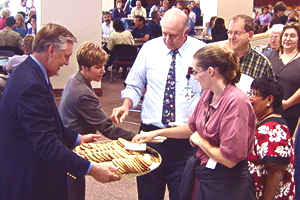 |
Commissioner Elwyn Tinklenberg served cookies to employees during an
Employee Recognition Week observance at the Central Office and then
lauded them for their many accomplishments. Photos by Mark Fischer
|
Mn/DOT employees throughout the department will receive a respectful nod of
appreciation for their work from Commissioner Elwyn Tinklenberg, Chief of Staff
Margo LaBau and Deputy Commissioner Doug Weiszhaar during the next few weeks
as they travel the state to express thanks for their efforts and accomplishments.
The visits come during the week proclaimed by Gov. Jesse Ventura as Minnesota
State Employment Recognition Week, the first such observation made by the Governor’s
Office.
Expressing his gratitude to Central Office employees on Sept. 16, Tinklenberg
praised all Mn/DOT employees for rising to several major challenges during his
administration.
Last week, Tinklenberg announced he will leave his post effective Oct. 4.
"The best piece of advice I got when I took this job is that Mn/DOT people
will respond to a challenge. And you did," he said.
Tinklenberg then recounted some of Mn/DOT’s accomplishments since his administration
began, including a greatly expanded construction program, the launch of the
Hiawatha light rail transit project, acceleration of highway projects and the
addition of new ones for an economic stimulus package in Northeastern Minnesota,
new business planning practices and the Moving Minnesota initiatives.
Mn/DOT people, he said, essentially packed 6.5 years’ work into 3.5 years to
ready more than $1.2 billion in construction projects.
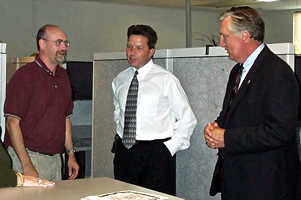 |
Commissioner Tinklenberg met informally with employees in Mankato and
thanked them for their contributions to Mn/DOT’s successes. He talked
with (from left) Steve Cray, transportation specialist, and District
Engineer Jon Huseby while visiting the Design Section. Photo by Deb
Yates
|
"This has not been an easy time," Tinklenberg said. "You met
the challenge. You’ve made it happen and your work is appreciated. This has
been a tremendous experience. Thank you so much."
In addition to the Central Office, Tinklenberg expressed his thanks on Monday
to employees of the Metro Division. He traveled to Mankato and Windom on Tuesday
and today met with employees in Duluth and Virginia. Future visits include Crookston,
Bemidji and Detroit Lakes on Sept. 25, and St. Cloud, Brainerd and Morris on
Oct. 2.
At Mankato, employees presented Tinklenberg with a baseball bat inscribed with
"Thanks for going to bat for us—Mn/DOT District 7" and a ball for
"being on the ball for transportation."
By Craig Wilkins
|
back

|
 |
State introduces online newsletter for its employees |
 |
 |
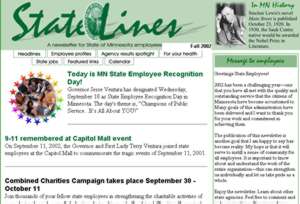 |
StateLines is the new online newsletter published by the State
of Minnesota for its employees.
|
Keeping up with what’s happening at other state agencies has become just a
bit easier with the launch today of StateLines, a new online newsletter
published by the State of Minnesota for its employees.
"My hope is that it will serve to instill a sense of community
for all employees," Gov. Jesse Ventura said in a written message to employees.
"It is important to know about and understand the work of the entire organization—this
can strengthen us individually and let us take pride as a whole."
The newsletter is expected to be published at least quarterly and will highlight
state agency news of general interest to all employees. The Fall 2002 issue
includes articles about the Sept. 11 memorial event at the Capitol, the Combined
Charities Campaign, open enrollment and the annual state employee health fair.
The newsletter also talks about how the Department of Health has confronted
new challenges and opportunities since Sept. 11 and about a health insurance
option that the Department of Human Services offers state employees with disabilities.
StateLines also has links to regular features, such as a calendar of
events, state jobs, health-related information, agency highlights and employee
profiles. Today’s issue, for example, features Mn/DOT’s Sue Barrick Smith, a
transportation generalist from the Litchfield Truck Station, as one of five
state employees profiled. Another link provides some general facts
about Mn/DOT, as well as links to information about other state agencies.
Click here to read StateLines.
|
back

|
 |
2000 census report shows significant changes in commuting patterns |
 |
 |
More Minnesotans are leaving for work before the start of the traditional rush
hour, according to figures released yesterday by the U.S. Census Bureau. The
data show a significant increase between 1990 and 2000 in the number of commuters
leaving for work before 6 a.m. The figures also show that the time it takes
for Minnesotans to get to work is increasing.
"This information underscores the fact that demand on our highway system
continues to increase both in terms of number of drivers and lengths of trips,"
said Commissioner Elwyn Tinklenberg.
"Demand is outpacing the funding available to provide a transportation
system that can adequately serve more commuters," he said, adding that
as travel demand increases, the state needs to provide more choices on how to
get to work. Statewide more than 315,000 Minnesota commuters are on the road
for 40 minutes and longer each day—an increase of 120,000 drivers between 1990
and 2000.
The number of commuters leaving home between 5 a.m. and 6 a.m. increased 56
percent between 1990 and 2000. Mn/DOT’s Traffic Management Center in the Twin
Cities recognized this change in commuting patterns and moved the start time
of its morning rush hour traffic reports from 5:30 a.m. to 6 a.m.
"With local TV and radio stations broadcasting traffic information even
earlier than that, our workload is increasing. We may need to adjust our start
times again given the trends," said Nick Thompson, TMC operations manager.
Another significant change in the census data involves longer commutes for
all Minnesotans. The number of commuters statewide who travel at least 40 minutes
to get to work increased 61 percent between 1990 and 2000. In the Twin Cities
metro area, that number increased 56 percent. At the same time, the percentage
of commuters whose daily trips to work took less than 20 minutes decreased slightly.
There are an estimated and 2.4 million commuters statewide and 1.4 million
commuters in the Twin Cities metropolitan area.
By Jeanne Aamodt and Pat Lund
|
back

|
 |
Mn/DOT rebuts transportation funding claims by Taxpayers League |
 |
 |
Mn/DOT released figures on transportation funding on Sept. 17 that correct
misinformation in a brochure the Taxpayers League recently distributed. The
brochure, titled Going Nowhere Slowly, was distributed to candidates
running for election this November.
The Taxpayers League is a non-profit organization that bills itself as a taxpayers’
advocacy organization.
"We agree that when it comes to transportation funding, Minnesotans are
going nowhere slowly," said Commissioner Elwyn Tinklenberg.
"The idea that we can improve our aging transportation system without
any new funding might be attractive, but it is not realistic," he said.
"This brochure contains information that is misleading and, in some cases,
just plain wrong."
One example of erroneous information, he said, is the league’s claim that transportation
spending has increased 109 percent since 1990. Spending on highway construction
increased only 34 percent between 1990 and 2000, from $390 million to $523 million.
Meanwhile, since the mid-1990s, costs in the highway construction industry
rose at twice the rate of inflation. This misinformation may stem from different
interpretations about the legislative allocation of $459 million in 2000, which
temporarily increased the transportation budget. That funding will be exhausted
in 2003 when funding will return to 1998-99 levels.
Another example of misinformation, Tinklenberg said, is the claim that billions
of dollars are being siphoned away from roads. The gas tax and vehicle registration
fees are constitutionally dedicated to roads and bridges and by law must be
spent on them. A portion of the Motor Vehicle Sales Tax is dedicated to transportation.
The remainder of MVST goes into the General Fund, which pays for education,
nursing homes, corrections and other government services, he added.
"The Taxpayers League would like us to believe that there is more than
enough money to pay for building and maintaining our roads," said Tinklenberg.
"The fact is that demand on our system is increasing much faster than funding."
The gas tax hasn’t been raised in 14 years in Minnesota and inflation has reduced
the value of the tax from 20 cents in 1988 to 13 cents today.
"Citizens and legislators need accurate information about this issue that
affects their daily lives," he added. Mn/DOT’s list of transportation facts
can be found by logging on to Mn/DOT’s Web site at: www.dot.state.mn.us/information/funding2002/fundingfacts.html.
By Pat Lund
|
back

|
 |
Yellow Medicine County engineer accepts new post at Willmar |
 |
 |
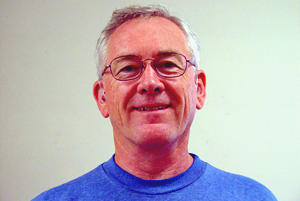 |
Barry Anderson, Yellow Medicine County engineer, will succeed Jeff
Vlaminck as regional engineer for operations at Willmar, effective Sept.
25. Staff Photo
|
Barry Anderson, Yellow Medicine County engineer, will succeed Jeff Vlaminck
as regional engineer for operations at Willmar. Anderson, who has been with
the county since 1983, takes the position held by Vlaminck who was appointed
as Owatonna area maintenance engineer with Rochester/District 6 in June.
In his new post, Anderson will manage maintenance operations and construction
in the area that includes Madison, Montevideo, Granite Falls and Willmar. His
appointment becomes effective Sept. 25.
Before joining the staff at Yellow Medicine County, Anderson served with the
South Dakota DOT working on interstate highway construction from 1968 until
1981.
Anderson may be reached at 320/214-3718.
|
back

|
 |
Peers honor Paul Walvatne’s contributions to greening of Minnesota |
 |
 |
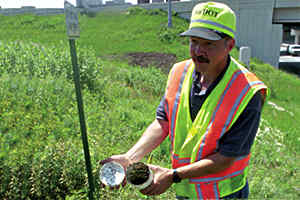 |
Forester Paul Walvatne, Environmental Services, releases flea beetles,
a natural enemy of the invasive non-native leafy spurge plant, in St.
Paul. He was honored for his contributions to roadside plant management
and tree care. Photo by Kevin Walker
|
Paul Walvatne, Forestry Unit supervisor in the Office of Environmental Services,
received both the Practitioner and President Awards at the Sept. 13 annual meeting
of the Minnesota Society of Arboriculture.
The Practitioners Award for Excellence recognizes a member for dedicated service
and practicing the art and science of tree care. The President's Award honored
Walvatne's role as "Keeper of the Green." According to Rich Hauer, society president,
"Paul has dedicated years of service to roadside and vegetation management.
He's also been great about sharing his expertise with others."
Walvatne thanked all "the dedicated and innovative Mn/DOT employees who help
make the 12,000 miles of Mn/DOT’s roadsides greener for all to enjoy."
Walvatne has served as a forester at Mn/DOT for 28 years.
By Sue Stein
|
back

|
 |
Transit Office staff bike, pool and ‘walk the talk’ to reach off-site staff meeting |
 |
 |
 |
Office of Transit staff members bike across a bridge on the Gateway
Trail on their way to a staff meeting. Among the riders are (from front)
Bob Works, Jennifer Leyde, Barb Quade and Desiree Quinn. Photo by
Mary Jackson
|
Mn/DOT's Office of Transit increased by eight employees when the Sustainable
Transportation Initiatives Section transferred from the Office of Environmental
Services.
"We welcome this partnership and want to make the transition as smooth as possible,"
said Donna Allan, director of the transit office. "One thing we're working on
is how transit, bicycling and pedestrian travel can work well together."
In order to acquaint transit staff with bike facilities in the community, the
office held a multi-modal staff meeting Sept. 10 at McCarron's Park in Roseville
to get a first-hand look at local bike facilities.
Instead of checking out cars from the Central Office garage, employees arrived
at the site a variety of ways. Ten staff members chose to bike along the roadway
and two bike trails, Gateway and Trout Brook, to get there. Others hopped on
a bus at Rice Street and University Avenue for the trip. Still others vanpooled
to the site or vanpooled to the walking path and continued their journey.
Since the merger, staff members are working on realigning functions and educating
each other on the differences and similarities of the modes. It is considering
a name change that will incorporate the various modes and more clearly delineate
its mission.
"We feel this is a great opportunity to teach one another and prompt each one
of us to consider the various ways we can get to our destinations," said Allan.
"I'm taking my bike into the shop for a tune-up so I have another transportation
choice."
By Sue Stein
|
back

|
 |
Insurance open enrollment period begins Oct. 1 |
 |
 |
With open enrollment just around the corner, state employees can expect to
receive open enrollment packets in their home mailboxes within the next few
days. Open enrollment will begin on schedule this year, and employees have the
month of October to select their employer-sponsored insurance benefits for 2003.
An update of State Employees Group Insurance Program benefits will be delivered
to all insurance-eligible state employee households during September. DOER will
then mail a customized open enrollment materials packet during the first week
of October. This packet will contain:
Employees should review this packet to verify its accuracy.
For employees who wish to get a head start on reviewing their options, the
Department of Employee Relations expects to post information on its DOER Web
site by September 23. These postings will include the clinic directory, guides
to plans & rates, links to health insurance providers, and enrollment forms.
The schedule
of open enrollment training sessions to be held around the state is available
now.
Changes this year include:
-
Out-of-pocket maximums will increase for everyone.
-
Some employees’ medical insurance payroll deductions may increase.
-
Payroll deductions will occur on a semi-monthly basis instead of biweekly.
-
Out-of-pocket charges could change significantly for some clinics that
have changed from their previous cost-level group.
-
Some domestic partners will no longer be eligible for coverage because
some contracts and plans offering benefits to same-sex partners did not
receive legislative approval.
-
University of Minnesota employees and their eligible dependents will withdraw
from the state’s plan effective Jan.1, 2003. State workers married to U
of M employees can now get coverage under both their own and their spouse’s
insurance benefit plans.
Employees may also review the state’s Advantage Plan and download forms from
the Mn/DOT Human Resources Web
site.
|
back

|
 |
|
 |



